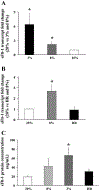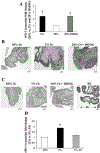Increased expression of sFlt-1 in in vivo and in vitro models of human placental hypoxia is mediated by HIF-1
- PMID: 16627691
- PMCID: PMC6428068
- DOI: 10.1152/ajpregu.00794.2005
Increased expression of sFlt-1 in in vivo and in vitro models of human placental hypoxia is mediated by HIF-1
Abstract
Elevated expression of soluble vascular endothelial growth factor receptor-1 (sFlt-1) in preeclampsia plays a major role in the pathogenesis of this serious disorder of human pregnancy. Although reduced placental oxygenation is thought to be involved in the pathogenesis of preeclampsia, it is unclear how oxygen regulates placental sFlt-1 expression. The aims herein were to investigate sFlt-1 expression in in vivo and in vitro physiological and pathological models of human placental hypoxia and to understand the role of hypoxia inducible factor-1 (HIF-1) in regulating the expression of this molecule. sFlt-1 expression in placental villi was significantly increased under physiological low oxygen conditions in early first-trimester and in high-altitude placentae, as well as in pathological low oxygen conditions, such as preeclampsia. In high-altitude and in preeclamptic tissue, sFlt-1 localized within villi to perivascular regions, the syncytiotrophoblast layer, and syncytial knots. In first-trimester villous explants, low oxygen, but not hypoxia-reoxygenation (HR), increased sFlt-1 expression. Moreover, exposure of villous explants to dimethyloxalyl-glycin, a pharmacological inhibitor of prolyl-hydroxylases, which mimics hypoxia by increasing HIF-1alpha stability, increased sFlt-1 expression. Conversely, HIF-1alpha knockdown using antisense oligonucleotides, decreased sFlt-1 expression. In conclusion, placental sFlt-1 expression is increased by both physiologically and pathologically low levels of oxygen. This oxygen-induced effect is mediated via the transcription factor HIF-1. Low oxygen levels, as opposed to intermittent oxygen tension (HR) changes, play an important role in regulating sFlt-1 expression in the developing human placenta and hence may contribute to the development of preeclampsia.
Figures





Similar articles
-
Extra-placental expression of vascular endothelial growth factor receptor-1, (Flt-1) and soluble Flt-1 (sFlt-1), by peripheral blood mononuclear cells (PBMCs) in normotensive and preeclamptic pregnant women.Placenta. 2005 Aug;26(7):563-73. doi: 10.1016/j.placenta.2004.09.001. Placenta. 2005. PMID: 15993706
-
Attenuation of VEGFR-2 expression by sFlt-1 and low oxygen in human placenta.PLoS One. 2013 Nov 19;8(11):e81176. doi: 10.1371/journal.pone.0081176. eCollection 2013. PLoS One. 2013. PMID: 24260556 Free PMC article.
-
[Expression of hypoxia-inducible factor-1alpha, vascular endothelial growth factor and sFlt-1 in preeclampsia placenta].Zhonghua Fu Chan Ke Za Zhi. 2006 Jul;41(7):440-4. Zhonghua Fu Chan Ke Za Zhi. 2006. PMID: 17083805 Chinese.
-
Adriana and Luisa Castellucci Award lecture 2001. Hypoxia inducible factor-1: oxygen regulation of trophoblast differentiation in normal and pre-eclamptic pregnancies--a review.Placenta. 2002 Apr;23 Suppl A:S47-57. doi: 10.1053/plac.2002.0815. Placenta. 2002. PMID: 11978059 Review.
-
Regulation of placental vascular endothelial growth factor (VEGF) and placenta growth factor (PIGF) and soluble Flt-1 by oxygen--a review.Placenta. 2000 Mar-Apr;21 Suppl A:S16-24. doi: 10.1053/plac.1999.0524. Placenta. 2000. PMID: 10831117 Review.
Cited by
-
Hypoxia and Mitochondrial Dysfunction in Pregnancy Complications.Antioxidants (Basel). 2021 Mar 8;10(3):405. doi: 10.3390/antiox10030405. Antioxidants (Basel). 2021. PMID: 33800426 Free PMC article. Review.
-
Imbalances in circulating angiogenic factors in the pathophysiology of preeclampsia and related disorders.Am J Obstet Gynecol. 2022 Feb;226(2S):S1019-S1034. doi: 10.1016/j.ajog.2020.10.022. Epub 2020 Oct 20. Am J Obstet Gynecol. 2022. PMID: 33096092 Free PMC article. Review.
-
A lesson for cancer research: placental microarray gene analysis in preeclampsia.Oncotarget. 2012 Aug;3(8):759-73. doi: 10.18632/oncotarget.595. Oncotarget. 2012. PMID: 22929622 Free PMC article. Review.
-
Pre-eclampsia: pathogenesis, novel diagnostics and therapies.Nat Rev Nephrol. 2019 May;15(5):275-289. doi: 10.1038/s41581-019-0119-6. Nat Rev Nephrol. 2019. PMID: 30792480 Free PMC article. Review.
-
Evidence for extraplacental sources of circulating angiogenic growth effectors in human pregnancy.Placenta. 2013 Dec;34(12):1170-6. doi: 10.1016/j.placenta.2013.09.016. Epub 2013 Oct 2. Placenta. 2013. PMID: 24161217 Free PMC article.
References
-
- American College of Obstetrics and Gynecology. Practice Bulletin. Diagnosis and management of preeclampsia and eclampsia. Int J Gynaecol Obstet 77: 67–75, 2002. - PubMed
-
- Ahmad S and Ahmed A. Elevated placental soluble vascular endothelial growth factor receptor-1 inhibits angiogenesis in preeclampsia. Circ Res 95: 884–891, 2004. - PubMed
-
- Banks RE, Forbes MA, Searles J, Pappin D, Canas B, Rahman D, Kaufmann S, Walters CE, Jackson A, Eves P, Linton G, Keen J, Walker JJ, and Selby PJ. Evidence for the existence of a novel preg nancy-associated soluble variant of the vascular endothelial growth factor receptor, Flt-1. Mol Hum Reprod 4: 377–386, 1998. - PubMed
-
- Benirschke K Recent trends in chorangiomas, especially those of multiple and recurrent chorangiomas. Pediatr Dev Pathol 2: 264–269, 1999. - PubMed
Publication types
MeSH terms
Substances
Grants and funding
LinkOut - more resources
Full Text Sources
Other Literature Sources
Medical

